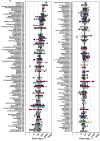Expanded Target-Chemical Analysis Reveals Extensive Mixed-Organic-Contaminant Exposure in U.S. Streams
- PMID: 28401767
- PMCID: PMC5695041
- DOI: 10.1021/acs.est.7b00012
Expanded Target-Chemical Analysis Reveals Extensive Mixed-Organic-Contaminant Exposure in U.S. Streams
Abstract
Surface water from 38 streams nationwide was assessed using 14 target-organic methods (719 compounds). Designed-bioactive anthropogenic contaminants (biocides, pharmaceuticals) comprised 57% of 406 organics detected at least once. The 10 most-frequently detected anthropogenic-organics included eight pesticides (desulfinylfipronil, AMPA, chlorpyrifos, dieldrin, metolachlor, atrazine, CIAT, glyphosate) and two pharmaceuticals (caffeine, metformin) with detection frequencies ranging 66-84% of all sites. Detected contaminant concentrations varied from less than 1 ng L-1 to greater than 10 μg L-1, with 77 and 278 having median detected concentrations greater than 100 ng L-1 and 10 ng L-1, respectively. Cumulative detections and concentrations ranged 4-161 compounds (median 70) and 8.5-102 847 ng L-1, respectively, and correlated significantly with wastewater discharge, watershed development, and toxic release inventory metrics. Log10 concentrations of widely monitored HHCB, triclosan, and carbamazepine explained 71-82% of the variability in the total number of compounds detected (linear regression; p-values: < 0.001-0.012), providing a statistical inference tool for unmonitored contaminants. Due to multiple modes of action, high bioactivity, biorecalcitrance, and direct environment application (pesticides), designed-bioactive organics (median 41 per site at μg L-1 cumulative concentrations) in developed watersheds present aquatic health concerns, given their acknowledged potential for sublethal effects to sensitive species and lifecycle stages at low ng L-1.
Figures






References
-
- Schäfer RB, Kühn B, Malaj E, König A, Gergs R. Contribution of organic toxicants to multiple stress in river ecosystems. Freshwater Biol. 2016;61(12):2116–2128.
-
- Doyle E, Biales A, Focazio M, Griffin D, Loftin K, Wilson V. Effect-Based Screening Methods for Water Quality Characterization Will Augment Conventional Analyte-by-Analyte Chemical Methods in Research As Well As Regulatory Monitoring. Environ Sci Technol. 2014;49(24):13906–13907. - PubMed
-
- Bright PR, Buxton HT, Balistrieri LS, Barber LB, Chapelle FH, Cross PC, Krabbenhoft DP, Plumlee GS, Sleeman JM, Tillitt DE, Toccalino P, Winton J. US Geological Survey environmental health science strategy: providing environmental health science for a changing world. US Geological Survey Circular 1383–E; 2013
MeSH terms
Substances
Grants and funding
LinkOut - more resources
Full Text Sources
Other Literature Sources

